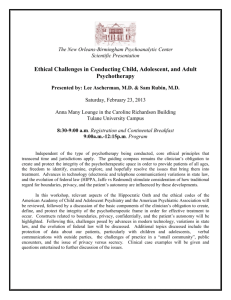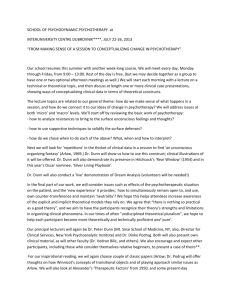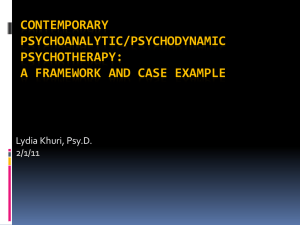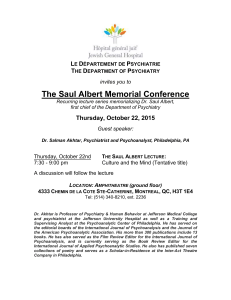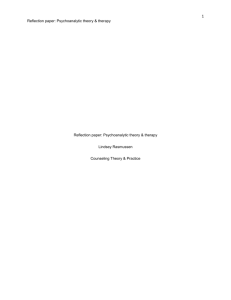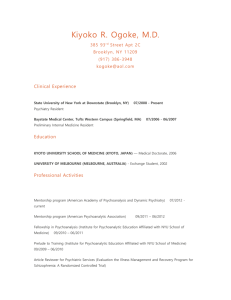the history of efpp - AEPP Asociación Española de Psicoterapia
advertisement
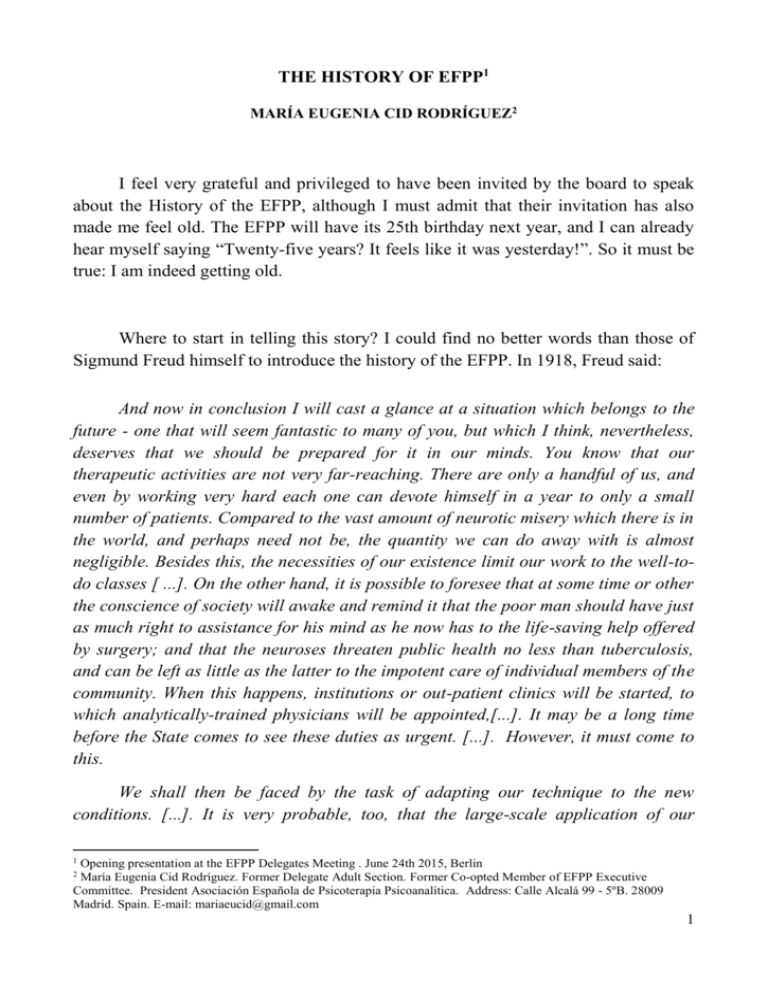
THE HISTORY OF EFPP1 MARÍA EUGENIA CID RODRÍGUEZ2 I feel very grateful and privileged to have been invited by the board to speak about the History of the EFPP, although I must admit that their invitation has also made me feel old. The EFPP will have its 25th birthday next year, and I can already hear myself saying “Twenty-five years? It feels like it was yesterday!”. So it must be true: I am indeed getting old. Where to start in telling this story? I could find no better words than those of Sigmund Freud himself to introduce the history of the EFPP. In 1918, Freud said: And now in conclusion I will cast a glance at a situation which belongs to the future - one that will seem fantastic to many of you, but which I think, nevertheless, deserves that we should be prepared for it in our minds. You know that our therapeutic activities are not very far-reaching. There are only a handful of us, and even by working very hard each one can devote himself in a year to only a small number of patients. Compared to the vast amount of neurotic misery which there is in the world, and perhaps need not be, the quantity we can do away with is almost negligible. Besides this, the necessities of our existence limit our work to the well-todo classes [ ...]. On the other hand, it is possible to foresee that at some time or other the conscience of society will awake and remind it that the poor man should have just as much right to assistance for his mind as he now has to the life-saving help offered by surgery; and that the neuroses threaten public health no less than tuberculosis, and can be left as little as the latter to the impotent care of individual members of the community. When this happens, institutions or out-patient clinics will be started, to which analytically-trained physicians will be appointed,[...]. It may be a long time before the State comes to see these duties as urgent. [...]. However, it must come to this. We shall then be faced by the task of adapting our technique to the new conditions. [...]. It is very probable, too, that the large-scale application of our 1 Opening presentation at the EFPP Delegates Meeting . June 24th 2015, Berlin María Eugenia Cid Rodríguez. Former Delegate Adult Section. Former Co-opted Member of EFPP Executive Committee. President Asociación Española de Psicoterapia Psicoanalítica. Address: Calle Alcalá 99 - 5ºB. 28009 Madrid. Spain. E-mail: mariaeucid@gmail.com 2 1 therapy will compel us to alloy the pure gold of analysis freely with the copper of direct suggestion; and hypnotic influence, too, might find a place in it again, as it has in the treatment of war neuroses. But, whatever the elements out of which it is compounded, its most effective and most important ingredients will assuredly remain those borrowed from strict and untendentious psycho-analysis [Freud, 1918, pp. 166168] . I wanted to start off with this lengthy quote from Freud you all no doubt are familiar with because, as the leader of modern thought and knowledge, Freud had the amazing ability of getting a head start on the future, of imagining the world to come. To a greater or lesser extent and across different times and places, that future world made its appearance throughout history at times of turbulence, at a cost of great social suffering followed by a spur of subsequent growth. In the USA as well as in some parts of Europe, psychoanalysis thus grew by leaps and bounds after World War II, a time in which human suffering spread dramatically, thereby prompting the need to develop some way of elaborating that horror, of repairing the damage and destruction. Psychoanalytic psychotherapy began to grow out of psychoanalysis and to evolve in parallel to the economic and social progress witnessed in the following decades. In contrast, in some other European countries, wars and dictatorships wanted to eliminate the development of psychoanalytic knowledge, sparking new migratory movements that always accompanied the psychoanalytic world in its ongoing resistance to defeat and in its search for knowledge wherever it may be. Moreover, analytical thought has also withstood, perhaps because the ideal of the democratization of psychoanalysis not only adhere to Freud’s idea of a “psychotherapy for the people”. Freud truly democratized human beings by endowing them with an unconscious. Thus, despite the social, political, economic, historical, cultural, and geographical avatars, there has always been (and always will be) an unconscious seeking to be psychoanalytically understood. In its search, the unconscious has found understanding in psychoanalysis and psychoanalytic psychotherapy, with the enormous complexity that has always existed in the relationship between the two. By the 1950s, a number of authors (Eissler, Merton Gill, Rangell, Stone) began identifying similarities and differences between psychoanalysis and 2 psychoanalytic psychotherapy. One of the main ideas bandied about in that decade was to preserve the “purity” of the psychoanalytic technique, based on the development of the neurosis of transference and its resolution by means of analyzing the transference, and making a clear-cut difference with other methods. Thus, psychoanalytic psychotherapy became suspect of “impurity". This differentiating effort continued into later decades, and occurred in context of social and economic expansion that led to increased demand for all types of psychoanalytic treatments, and in some countries, even to it being included in their national health service and insurance plans. The world of psychoanalysis joined this expansion, albeit with very different degrees of influence in each country. Over time, the search for “pure gold” ceased. Pure gold does not exist, as Hinshelwood stated. Today, there seems to be a general consent to admitting that psychoanalysis and psychoanalytic psychotherapy share the same theoretical underpinnings and differ in their technical procedures. But what model of the mind are we talking about here? Psychoanalysis is a living, dynamic phenomenon, and has been evolving continuously since its very start. Psychoanalytic thought has spread along many different lines throughout the world as well as across psychoanalytic institutions: French Freudians, British Kleinian-Bionians, English Freudians, Independents, Lacanians, Bionians beyond the borders of Britain, Intersubjectivists, Kohutians, Ego psychologists... all cohabiting the psychoanalytic world in dynamic tension. Each theoretic model of psychoanalysis has also developed different technical methods giving rise to other so many psychoanalytic psychotherapies, opening up a wide spectrum, ranging from advocates of not differentiating between psychoanalysis and psychoanalytic psychotherapy, to supporters of the radicalness of the differences, with all the shades and nuances of similarities and divergences between the two extremes. Added to this heterogeneity of factors intrinsic to the scientific debate is the convergence of external factors: historical, geographical, political, economic, social, group, institutional... All these outside factors are not only unavoidable, they are inherent to the evolution of psychoanalytic thought as a whole, even when these factors take over and interfere by acting as anti-psychoanalytic thinking. 3 Freud’s hopeful predictions for the future began to come true in this Babel heterogeneity; nevertheless, in some parts of the world they still seem like castles in the sky. In any case, as psychoanalytic psychotherapy developed, it stopped being only the psychotherapy Freud adumbrated for the people and little by little became a psychoanalytic option on its own right, with its own identity, to take on a wide range of psychopathologies and conditions of the inner and outer worlds. This evolution has not been without controversy. One important one came about from the establishment of the first societies for psychoanalytic psychotherapy, which brought about a major change: training in psychoanalytic psychotherapy was now accessible outside the realm of the psychoanalytic institutions. For Wallerstein, this was the moment in which psychotherapy emerged from its pre-history. And I would add that it is the realm in which the EFPP got its start. In the late 1980´s, early 90´s, major changes were occurring in the European Union regulations freeing up the movement of professionals between countries. Brian Martindale, at the time secretary of the Association of Psychoanalytic Psychotherapy in the NHS in the UK, sensed that an European organization of psychoanalytic psychotherapy was needed. Brian Martindale has been the driving force of the EFPP, founder and first chairman of the organization. With his creative, psychoanalytic and organizational mind, with his indefatigable working capacity and his deep commitment to psychoanalytic psychotherapy, he began placing the preliminary cornerstones of the EFPP, both with colleagues in the UK and through extensive links he made in European countries. In November 1988 the First European Psychoanalytic Psychotherapy Conference was held, which was well attended by 150 participants from 15 different countries. At that meeting there was a groundswell of opinion to be aiming towards forming a Federation for Psychoanalytic Psychotherapy. After 3 years of intensive work, in February 1991 in London, in the 2 nd European Psychoanalytic Psychotherapy Conference, the EFPP was founded, and concluded with the adoption of a Constitution and the 1st meeting of its elected Executive Committee. That foundation meeting was brilliantly chaired by Anton Obholzer of the Tavistock Clinic, who was also very helpful in the planning stages. 4 Just as Freud heralded, “at the heart of the EFPP was and is a determination that knowledge and treatment skills stemming from psychoanalysis should become much more widely available and applicable to the general public with mental health problems who come for help from the caring professions, and in which psychoanalytic psychotherapy clearly differentiated itself from other types of psychotherapy” (B. Martindale). The EFPP was born with a number of linked objectives, scientific as well as political. On one hand, one of its aims was to define, protect and promote high standards in training and practice; to facilitate the exchange of ideas and communication among psychoanalytic psychotherapists. And on the other hand, it also aimed to influence public policy on regulating the practice of psychoanalytic psychotherapy. The EFPP was founded; there was an idea of what the EFPP would become, but the way to achieve this had to be invented from scratch. No structure existed, unless at first in Brian´s head, and then on the board of the founding executive. This is perhaps a good moment to recall with gratitude, the pioneers of the EFPP who, along with Brian Martindale, gave life to the organizational structure: John Tsiantis, Serge, Frish, Miranda Feuchwang, Birgit Hallerfors, Rita Pölönen, Jan van de Sande, Liselotte Grünbaum, Luc Moyson, Rudolf Balmer, Lydia Tischler, Julia Pestalozzi, Margareta Mörner, Inger Larsson and, last but not least, the incredible Secretary, Joyce Piper, who managed to start up the administrative machinery of the EFPP back in the pre-internet days of pen and paper, snail mail, faxes and rotary dial phones. All these people knew how to create a work environment that stimulated the development of national networks in the various different countries. The EFPP organization was conceived on the basis of the independent development of three sections: Adults, Children and Adolescents, and Groups. It seemed necessary to have these three sections rather than just a vague conglomerate of psychoanalytic psychotherapies bunched together in a single group. There were two forms to develop the sections: 1) to create the national network first, and then create the three sections, or 2) to create the section network first without connection to the other sections and only later, when each section had worked out its way of functioning, to found the national network. As Brian Martindale himself stated in his first communication from the EFPP Executive: "It is essential that further developments happen in each country towards 5 formal national representation of organizations of the three sections. Each country must work out its own way of doing things.... By EFPP constitution you are all quite free to work out what is best for your country. This will be the route through which each country has a voice in the EFPP and it is my hope that these national networks or organizations will also enable each country to be more effective within that country in speaking up for the development of psychoanalytic psychotherapy in the public sector". I highlight these words from Martindale because from the very start he had in mind the aim of joining the common and the different, the homogenous and the heterogeneous, the otherness and the sameness with special respect for the member countries, represented by the Delegates at the core of the EFPP. John Tsiantis attached particular importance to his role as Vice-Chairman of the EFPP since its foundation. He has contributed in various ways to the development of the EFPP; most notably, he was the initiator of section scientific conferences and also fostered the three section conferences. His enthusiasm led him to promote holding a yearly conference on the three sections, and in annually successive years, conferences on each section. A few years later it was found that the pace of the three section conferences needed to be reduced. From the outset, the conferences were a single setting for deploying the differences in the EFPP: different countries, different cities, different languages, foods, colors, lights, smells, music, etc. which the hosting delegates, the national networks and colleagues have always offered to all the EFPP members with great enthusiasm, generosity, and effort. Each and every conference, along with the delegates meetings, has been and is the most direct expression of the life of this organization. The style of the EFPP conferences has become traditional: in the morning, plenary sessions with well known main speakers, followed by small discussion groups on the conferences; the afternoons being dedicated to workshops and paper presentations in smaller groups. The small discussion groups were much appreciated ever since the beginning, since they help the participants digest the main lectures and link them to their own practice, clinical experience but also to their experience in the conference. The small discussion groups also provide a main venue for exchange among professionals from different countries and different psychoanalytic cultures. This makes it a place where 6 the unconscious phantasies on the different models of understanding psychoanalytic psychotherapy are challenged or reinforced. It is a Babel-like exchange that bears witness to the tendency in the groups of dealing with otherness and/or sameness. Sometimes the groups are able to transform the differences into exciting discussions; other times they become stuck in the struggles against the differences or in very rigid splitting that preclude thinking and learning. These groups have been vitally important to the EFPP’s conferences, and it is a delicate task for the group leaders, who receive and must contain a great deal of unconscious emotionality that sometimes comes not only from the congress, but also from the EFPP as a whole. It was therefore deemed necessary to hold meetings before, during and after the conference, with the group of leaders, to help them keep to the work group task. These meetings were not hold jointly with the chairpersons, and were led by a member of the board, preferably from the group section. Serge Frish, the second president of the EFPP, was very active from the start as coordinator of the adult section. With great intuition, organizational ability and skillful leadership, along with many other contributions, he always made great efforts to develop the EFPP in French-speaking countries. Serge wanted to develop their specificity inside the EFPP, namely in the development of French-speaking conferences. Thus, in February 1999, he organized the first French-speaking conference of the EFPP in Belgium: "Les cliniques psychotherapeutiques aujord´hui". From the outset, the EFPP also thought of how important it was to hold conferences, but also to promote smaller gatherings of Special Interest Groups. Thus, our dear Greek colleagues John Tsiantis, Dimitris Anastasopoulos and Effie Lignos organized the Summer Workshop on child and adolescent subjects, on the marvelous island of Syros, starting in 1998, and being held successfully every other year ever since. Also pioneers in organizing this kind of special interest groups were André Gautier, who headed a group on “Torture victims”, and Olivier Nicole, on “Research in Psychoanalytic Psychotherapy.” Of course, books also assist the spread of knowledge, and their study stimulates fresh thinking. It was with this in mind that it was decided to start the series of EFPP monographs on highly relevant clinical topics. Once again, John Tsiantis was the one who embarked on the adventure of the Monographs. Initially, the idea was to publish two Monographs per year, the first ones published by Karnac, and it would be a place to give written account of the EFPP’s congresses. But it was also conceived as a 7 meeting place, somewhere to exchange the different theories and practices of psychoanalytic psychotherapy that characterize the EFPP. The first Monograph, “On Countertransference in Psychoanalytic Psychotherapy with Children and Adolescents”, dates back to 1995. Brian Martindale also edited the firsts Newsletters, an arena for information and communication for the EFPP members to show their national organizations and their activities. The other dimension to the EFPP has been political. The EFPP was created as a primordial organization in defense of the profession at a European level. All the boards of directors paid close attention to what was happening in Brussels, and more than a few meetings were held with representatives from the European Commission. In a 1997 report issued by a representative (Mr Pereira), it was clear that the European Commission was not going to regulate the psychotherapy profession on the European level and had no intention of doing so in the near future, leaving it up to the member countries to develop this goal in their own countries. Nor would they issue any European Certification of Psychotherapy. However, they did encourage the professional bodies to draw up widely accepted European training standards to facilitate the move and the professional settling of psychotherapists throughout Europe. They also advised getting in touch with national representatives in the Ministries who were in charge of psychotherapy issues, to influence national legislation, and in particular training standards regarding psychotherapy. This was rather disappointing to many of us who saw the EFPP as a means of pushing the process of recognizing psychotherapy and regulating it in the European Community. It had to be acknowledged that the differences in the concept of psychotherapy and the regulations of it were enormous between countries in Europe. Those days were not easy, because one of the EFPP’s main objectives was thus being thwarted. Nevertheless, in some ways the EFPP also provided some cohesion in a fragmented field by helping the existing national bodies to discuss together and so to come closer and by agreed-upon training standards, which we believe are basic for a proper training as a psychoanalytic psychotherapist. In any case, the EFPP would most likely have split up if not for the scientific aspects. But instead of splitting up, the EFPP kept on growing: the number of member countries increased to include the countries in Central and Eastern Europe as they too joined the European Union. Here we must recall the tremendous contribution made 8 by Lydia Tischler in organizing the first steps in bringing the new countries into the EFPP, and in carrying out an important job of teaching in those countries. It was also growing in sections: in 1999, at Pierre Benghozi´s suggestion and enthusiasm and in view of the increasing interest in development of the Psychoanalytic Couple and Family Psychotherapy, the EFPP board decided to set up a working party to explore the situation in Europe and to formulate a proposition of how PCFP could be organized within the EFPP. This work ended six years later with the implementation of the Fourth Section, although, as with many other matters in the life of the EFPP, we can not really talk of works being fully completed, because they are in continuous movement, so they are always being thought over. The EFPP and its institutional interrelations were also being transformed with all the new developments in technology. Beyond a doubt, the “net” made communication quicker and more efficient, and shortened distances. Or is that just another castle in the sky? This brings me to my conclusions regarding the present and future of the EFPP. The delegates’ meeting and the scientific meeting that summons us all here under the title “Beyond Babel: on sameness and otherness” offers a new opportunity to keep thinking through this organization. Let us recall the Myth of Babel: Now the whole world had one language and a common speech. As people moved eastward, they found a plain in Shinar and settled there. They said to each other, “Come, let’s make bricks and bake them thoroughly.” They used brick instead of stone, and tar for mortar. Then they said, “Come, let us build ourselves a city, with a tower that reaches to the heavens, so that we may make a name for ourselves; otherwise we will be scattered over the face of the whole earth.” But the LORD came down to see the city and the tower the people were building. The LORD said, “If as one people speaking the same language they have begun to do this, then nothing they plan to do will be impossible for them. Come, let us go down and confuse their language so they will not understand each other.” So the LORD scattered them from there over all the earth, and they stopped building the city. That is why it was called Babel—because there the LORD confused the language of the whole world. From there the LORD scattered them over the face of the whole earth. (Genesis 11:1-9). 9 Our esteemed and much missed León Grinberg told us that “myths can be compared to a mobile, multifaceted polyhedron that, depending on the angle at which we look at it, shows us different faces, sides or edges". He considered that “the narrative in myths has important elements for understanding unconscious phantasies that the patient relives in their transferential link to the analyst". I would say that myths also offer elements for understanding the unconscious life of organizations. According to Grinberg, the myth of Babel offers the chance to make more sense out of the psychotic part of the personality that actively opposes the knowledge and organization of the Ego in touch with reality. In this myth, we can see man trying to attain knowledge and communication, to reach the knowledge from “another world”, different from the known world, and a cruel and all-powerful god who is opposed to that, and punishes them by confusing their languages, creating misunderstanding and destroying their ability of communicate. But if we look at this myth with that polyhedral vision, from another more benevolent and neurotic side, we can believe that the god uses confusion to punish the arrogant attempt at attaining single-minded, fanatical, omnipotent knowledge and narcissistic communication in which differences do not exist and only sameness inhabits. In this case, confusion emerges as a preconception to creating diversity, thought, communication with the other (otherness), change, creativity and growth. The psychotic Babel, as we can call it, is anti-growth, and wreaks havoc on personality, on humanity, and on organizations when they stubbornly insist on reducing us to sameness by attacking thought and reality, and can negatively transform heterogeneity, diversity into fragmentation, isolation, emptiness and psychic death. But in the neurotic Babel, human beings and the organizations also try to change the confusion of Babel into new ways of approaching knowledge and dealing with differences. In individuals and in organizations, these states oscillate dynamically. Organizations are supposed to provide systems for containing and contemplating these states without harm. The balance of organizations largely depends on the functionality of this dynamic tension between the different Babels: staying too long in the neurotic Babel may perhaps lead to stiffness, immobility, inability to change. Staying too long in the position of the psychotic Babel may give rise to psychotic confusion, fragmentation, inability to integrate and therefore also to great difficulties during times of change. 10 At the start, the EFPP found itself immersed in the confusion of psychoanalytic languages, different organizational realities, different trainings, different levels of development in psychoanalytic psychotherapy, different regulations in the different countries. Perhaps we may say that it found itself in the psychotic version of the myth of Babel. The pioneers were very aware of this confusion and tried to lay the ground stones for living together in a more civilized fashion. We can say that they tried to construct a containing organizational space in which otherness and sameness could live together and oscillate creatively and constructively. In this space, Babelic confusion could be transformed into growth of psychoanalytic psychotherapy. There have been small and large crises along the way. Moments in which, perhaps to avoid Babelic confusions, unconscious threats of splitting appeared: the English-speaking EFPP and the French-speaking EFPP, the rich EFPP and the poor EFPP, the EFPP from the north and the EFPP from the south, from the east and from the west. At other times, the confusion was anything but contained and lessened, and it seemed to increase with changes in constitution and by-laws and premature integrations. After nearly 25 years, the EFPP is still trying to strike a balance and make sense of this oscillating world of Babels. Perhaps that is what characterizes its identity and its function: trying to sustain the heterogeneity in unity; containing cohesion and integration in this Babelic world. I believe the EFPP must broaden the spaces for thought, for communication, for contact with the inner and outer world of the organization: it has to provide ongoing and creative spaces for dialogue among differences, to face new changes, new challenges, new Babels. Well then, that is my story on the history of the EFPP. It is now your turn to keep building yours and to keep building the history of the future of the EFPP. Thank you very much. Bibliography - Bible: Genesis 11: 1-9. 11 - Cid Rodríguez, M E. (2013). Presentación del Monográfico “Psicoanálisis y Psicoterapia”. Revista de Psicoanálisis de la APM 68: 716. - Corrente, G. (1999). Cohesión y fragmentación en el grupo psicoanalítico. EFPP Conference: From Fragmentation to Cohesion. Barcelona. - Freud, S. (1919 [1918]). Lines of Advance in Psycho-Analytic Therapy. SE 17. - Frisch, E. (ed) (2001). Psychoanalysis and Psychotherapy. The Controversies and the future. EFPP Clinical Monograph Series. London: Karnac - Grinberg, L. (1981). Psicoanálisis. Aspectos teóricos y clínicos. Buenos Aires: Editorial Paidós. - Grinberg, L ., Grinberg, R. (1989). Psychoanalytic Perspectives on Migration and Exile. London: Yale University Press. 12

